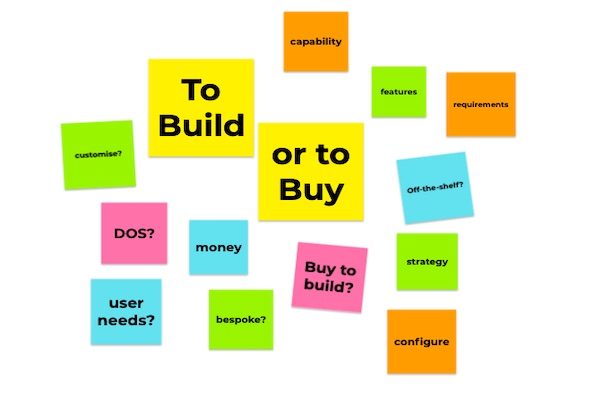
Not long ago, we updated guidance in the Technology Code of Practice on purchasing strategies to include more information on when to build or buy, customise or configure technology.
Thinking about when to build and when to buy
This is a common decision most people have to make. Shall I cook or get a takeaway? Shall I buy ready made furniture or build a flatpack?
The same is true of government departments, who have historically relied on outsourcing or buying off-the-shelf products instead of building and developing in-house capability. But as more departments hire DDaT professionals and have the internal capability to build services and products themselves, the choice between building, buying or a combined approach to technology is becoming more complex.
Over the last year, we’ve spoken to departments about their thoughts on making build versus buy decisions and noticed a few things.
Your project’s needs are more likely to be common than unique
It’s likely for a lot of projects that configuring commercially available technology will work well. However, it’s easy to come to the conclusion that your organisation’s needs are sufficiently complex or unique that you need a bespoke technology solution.
This can lead some organisations to develop their own products or services from scratch, where commercially available solutions might offer better value for money. For others, this can lead teams to over-customise off-the-shelf products to fit a process or service that might benefit from a redesign. In most cases, customisation is not only expensive, but can make the product or service harder to maintain or update. This effectively reduces the benefits you’ve gained by using an off-the-shelf product.
Of course, your product or service becomes pointless if your users can’t use it. So the most important elements of choosing whether to buy or build is that it works and it meets user needs.
Deciding if something is a core business competency or not
It can make more sense to buy an off-the-shelf product if your requirements are very common and easily met by suppliers. For example, you’re better off buying an email service than building it yourself. But, if your organisation is a passport checking provider then it might be better to build the passport-checking tool because it’s your core business competency.
Sometimes, things are not so straightforward and you might need to take a combined approach; for example, building some components of a service to limit the number of different platforms used in your organisation, or alternatively, taking the buy-to-build approach by hiring specialists to build your product for you.
If you share common user needs or journeys with other organisations, it's useful to consider where you can partner with them to share or reuse existing products or technology. And use open source and open standards where you can - this will help other organisations to build or buy services that work with your technology.
Capability and oversight is a big part of the decision making process
Technical and organisational capability will inform a lot of your strategy. Organisations with strong technical expertise are obviously more likely to consider building as an option than organisations with less technical expertise.
Regardless of the route you choose, you cannot outsource risk. It's important to make sure you have the resources, insight and knowledge to manage and oversee your products in the long-term - whether you build, buy or both.
Updated guidance on defining your purchasing strategy
We updated our guidance to better support organisations when they’re defining their purchasing strategies. We worked with technologists, commercial specialists and service designers to understand how different teams make decisions and get the most value from building or buying technology.
We also noticed some confusion around the differences between customisation and configuration, either of which can have a big impact on the life cycle of a purchased product. We updated the guidance to highlight differences and encourage configuration over customisation.
Deciding between building and/or buying a thing is not easy. This new guidance will help organisations think more broadly about their requirements and capabilities much earlier in their journey.
The new update also includes more information on defining your commercial approach. Creating a strong link between commercial and technology teams can help make sure your technology remains useful and meets your expectations throughout its lifecycle.
Always iterating
We want to keep the conversations going. If you have any feedback or anything you think we could add, please get in touch by emailing us at technology-policy@digital.cabinet-office.gov.uk, or leave a comment below.

2 comments
Comment by John Glover posted on
As you say, build should only ever be chosen if buy is not an option, especially for cloud commodity tools.
Comment by Emily posted on
Hello - I cant get your email address to work, could you drop me a line emily.connolly@go-science.gov.uk? I am interested in your experience and advice on options for solutions for sharing info across Whitehall 🙂